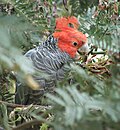Difference between revisions of "AY Honors/Parrots and Cockatoos/Answer Key"
(rv vand.) |
|||
| (2 intermediate revisions by the same user not shown) | |||
| Line 19: | Line 19: | ||
}} | }} | ||
| − | The '''Gang-gang Cockatoo''', ''Callocephalon fimbriatum '' | + | The '''Gang-gang Cockatoo''', ''Callocephalon fimbriatum '' is found in the cooler and wetter forests and woodlands of [[Australia]], particularly [[alpine]] [[bushland]]. Mostly mid grey in colour, the male has a red head and [[crest (bird)|crest]], while the female has a small fluffy grey crest. It ranges throughout south-eastern Australia and [[Tasmania]]. The Gang-gang Cockatoo is the faunal emblem of the [[Australian Capital Territory]]. It is easily identified by its distinctive call, which is described as resembling a creaky gate, or the sound of a cork being pulled from a wine bottle. |
| − | Gang-gang Cockatoos require solid | + | Gang-gang Cockatoos require solid trees for nesting, in which they excavate a nesting cavity with their strong bills. Loss of habitat across south-eastern Australia through land clearing has led to a significant reduction in the numbers of this [[cockatoo]] in recent years. |
==External links== | ==External links== | ||
Revision as of 22:07, 10 April 2006
The Gang-gang Cockatoo, Callocephalon fimbriatum is found in the cooler and wetter forests and woodlands of Australia, particularly alpine bushland. Mostly mid grey in colour, the male has a red head and crest, while the female has a small fluffy grey crest. It ranges throughout south-eastern Australia and Tasmania. The Gang-gang Cockatoo is the faunal emblem of the Australian Capital Territory. It is easily identified by its distinctive call, which is described as resembling a creaky gate, or the sound of a cork being pulled from a wine bottle.
Gang-gang Cockatoos require solid trees for nesting, in which they excavate a nesting cavity with their strong bills. Loss of habitat across south-eastern Australia through land clearing has led to a significant reduction in the numbers of this cockatoo in recent years.
External links
- ParrotScience - cockatoo heavy information site
- NSW National Parks & Wildlife - Proposed vulnerable species listing
- BirdLife Species Factsheet
References
- Flegg, Jim. Birds of Australia: Photographic Field Guide Sydney: Reed New Holland, 2002. (ISBN 1876334789)



